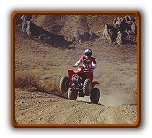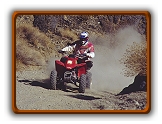2000 Honda 250ex review
| The Newest and Smallest Sportrax This Distinctive New Arrival Gets New Found Power from the Recon’s 229cc Engine |
 |
 Developing a new sport quad for the competitive first-time buyer’s ATV segment, Honda introduced the all-new Sportrax 250EX to the press at an intro ride in California’s Mojave Desert. Entry-level machines like the 250EX certainly aren’t the bread and butter moneymakers for OEM’s. There is however an excellent reason for developing this category of quad. By introducing new riders to an entry-level quad, it plays a pivotal role in extracting the kind of brand loyalty that OEM’s strive for with consumers. It’s a pretty simple process and pays off in the long run with huge dividends. Marketing people understand all too well that ATV consumers tend to be like any other consumer. Expose the younger crowd to your brand product, and unless something is terribly wrong with it, they have a strong tendency to buy another one down the line.
Developing a new sport quad for the competitive first-time buyer’s ATV segment, Honda introduced the all-new Sportrax 250EX to the press at an intro ride in California’s Mojave Desert. Entry-level machines like the 250EX certainly aren’t the bread and butter moneymakers for OEM’s. There is however an excellent reason for developing this category of quad. By introducing new riders to an entry-level quad, it plays a pivotal role in extracting the kind of brand loyalty that OEM’s strive for with consumers. It’s a pretty simple process and pays off in the long run with huge dividends. Marketing people understand all too well that ATV consumers tend to be like any other consumer. Expose the younger crowd to your brand product, and unless something is terribly wrong with it, they have a strong tendency to buy another one down the line. The new 250EX has traceable origins from two previous Honda quads. It shares components with the successful and proven Recon, but has a market segment resembling the groundbreaking FourTrax 200SX.
Introduced into the ’86 model year, the 200SX carved out its own niche for four-stroke sport machines and boasted three valuable assets that would appeal to beginning riders–an electric starter, a perky OHC four-stroke and a semi-automatic clutch. Just as the FourTrax 200SX was designed to bring new riders into the Honda family–so is the new 250EX.
The 250EX sports a 229cc OHV air-cooled engine and like all
 Honda shaft-drive quads, it’s longitudinally mounted in the double cradle steel frame. This configuration allows direct drive-shaft alignment to the rear wheels with less moving parts for more efficient power transfer. An efficient oil-cooler supplements the 2-quart capacity wet sump providing lower operating temperatures for increased engine life. A 20mm carburetor with a unique buffer plate in the float chamber helps maintain a consistent fuel flow regardless of terrain variance. A solid-state CD ignition has an 8750-RPM rev-limiter and the electric start engine has a 123-watt capacity alternator. Surprisingly, there is no backup recoil starting system. Access to the air filter is accomplished by sliding off four clips from the intake airbox lid. Although the engine has been pilfered off the Recon, a few performance features have been incorporated to deliver on the sporty side of the 250EX. A new two-valve cylinder head design features performance-optimized valve timing. A 31.5-mm diameter intake valve (1-mm larger than the Recon’s) and a 27-mm diameter exhaust valve produce a broader usable powerband. Also new is the 55-degree intake valve angle as compared to the Recon’s parallel intake valves. The 1-mm larger intake valve and more efficient angle give the 250EX 10% more power than the Recon. The new cylinder head gives it a slightly higher 9.2:1 compression ratio as compared to the Recon’s 9.0:1 The power increase is matched to a new set of higher gear ratios that give the 250EX a more “sporty” feel than the utility-oriented Recon. The semi-automatic (no hand clutching) gear shifts are easy, crisp and precise.
Honda shaft-drive quads, it’s longitudinally mounted in the double cradle steel frame. This configuration allows direct drive-shaft alignment to the rear wheels with less moving parts for more efficient power transfer. An efficient oil-cooler supplements the 2-quart capacity wet sump providing lower operating temperatures for increased engine life. A 20mm carburetor with a unique buffer plate in the float chamber helps maintain a consistent fuel flow regardless of terrain variance. A solid-state CD ignition has an 8750-RPM rev-limiter and the electric start engine has a 123-watt capacity alternator. Surprisingly, there is no backup recoil starting system. Access to the air filter is accomplished by sliding off four clips from the intake airbox lid. Although the engine has been pilfered off the Recon, a few performance features have been incorporated to deliver on the sporty side of the 250EX. A new two-valve cylinder head design features performance-optimized valve timing. A 31.5-mm diameter intake valve (1-mm larger than the Recon’s) and a 27-mm diameter exhaust valve produce a broader usable powerband. Also new is the 55-degree intake valve angle as compared to the Recon’s parallel intake valves. The 1-mm larger intake valve and more efficient angle give the 250EX 10% more power than the Recon. The new cylinder head gives it a slightly higher 9.2:1 compression ratio as compared to the Recon’s 9.0:1 The power increase is matched to a new set of higher gear ratios that give the 250EX a more “sporty” feel than the utility-oriented Recon. The semi-automatic (no hand clutching) gear shifts are easy, crisp and precise. For comparison testing of the 250EX’s engine power, Honda had brought along a few Recons and a few 300EX’s. Switching back and forth between machines made it obvious that the new 250 was much quicker than the Recon. This wasn’t too surprising as the Recon is 42-pounds heavier with 10% less power. What was surprising was the small margin of difference in speed between the 250EX and 300EX. The new 250 gave a decent account of itself in overall quickness. It was much closer to the 300EX in overall speed as compared to the Recon. But unless you’re going downhill, a distinct lack of overall power is noticed from the groaning engine when in fifth gear.
For comparison testing of the 250EX’s engine power, Honda had brought along a few Recons and a few 300EX’s. Switching back and forth between machines made it obvious that the new 250 was much quicker than the Recon. This wasn’t too surprising as the Recon is 42-pounds heavier with 10% less power. What was surprising was the small margin of difference in speed between the 250EX and 300EX. The new 250 gave a decent account of itself in overall quickness. It was much closer to the 300EX in overall speed as compared to the Recon. But unless you’re going downhill, a distinct lack of overall power is noticed from the groaning engine when in fifth gear.
Bottom Line on the Engine:
The 250EX addresses a nice compromise between the Recon and 300EX. The smooth-running engine’s power fills the gap between basic recreational riding and sport performance power.
 There are liberal doses of Honda’s familiar-looking Sportrax lineup throughout the 250. It has the same aggressive body style of the high-performance 400EX, along with suspension enhancing lightweight aluminum wheels. By the way, the 250EX has the exact same dual front hydraulic disc brake system as found on the 400EX. The rear brake is the same as the Recon’s mechanical drum. Stopping ability is excellent. The single-headlight system features a twin-filament high/low 35W/35W bulb. The display panel consists’ of neutral and reverse indicator lights. Thankfully, the 250 has the same easy-to-use reverse setup as the Recon rather than the 300EX.
There are liberal doses of Honda’s familiar-looking Sportrax lineup throughout the 250. It has the same aggressive body style of the high-performance 400EX, along with suspension enhancing lightweight aluminum wheels. By the way, the 250EX has the exact same dual front hydraulic disc brake system as found on the 400EX. The rear brake is the same as the Recon’s mechanical drum. Stopping ability is excellent. The single-headlight system features a twin-filament high/low 35W/35W bulb. The display panel consists’ of neutral and reverse indicator lights. Thankfully, the 250 has the same easy-to-use reverse setup as the Recon rather than the 300EX.The hand and foot controls are comfortably positioned and the long seat provided enough distance down to the footpegs for our 6’2″ test rider to not feel cramped. In short, the ergonomics of this 250-class quad will fit a wide range of riding sizes and styles.
 The independent front suspension is of the double wishbonetype and offers 5.9-inches of travel. The rear steel swingarm and single rear shock offer 5.7-inches of travel. Redesigned arms on the front and a 1-inch wider rear axle allow the 250EX a wider stance than the Recon. The lightweight aluminum wheels (plus no racks) make the 250 a trim 355-pounds (161 kg)– a 42-pound weight savings over the Recon. Dunlop AT tires with the same tread pattern as the 400EX grace the 250. Front tire measurements are 22×7-10 and the rears measure 22×10-9. Something worth mentioning is that of the six test machines, we didn’t see one quad with a flat tire at the end of our ride.
The independent front suspension is of the double wishbonetype and offers 5.9-inches of travel. The rear steel swingarm and single rear shock offer 5.7-inches of travel. Redesigned arms on the front and a 1-inch wider rear axle allow the 250EX a wider stance than the Recon. The lightweight aluminum wheels (plus no racks) make the 250 a trim 355-pounds (161 kg)– a 42-pound weight savings over the Recon. Dunlop AT tires with the same tread pattern as the 400EX grace the 250. Front tire measurements are 22×7-10 and the rears measure 22×10-9. Something worth mentioning is that of the six test machines, we didn’t see one quad with a flat tire at the end of our ride.
Honda has an almost unrivalled ability to develop great OEM sport quadsuspensions–the 250EX is no different. Test ridingthe 250EX in California’s Mojave Desert would prove it. The fine people at Honda had picked a delightful set of BLM trails that would offer the press a good feel for what the suspension and engine had to offer. There were no major hillclimbs included in the test trails, but we had a multitude of fast straightaways, and twisty off-cambers with a few erosion washouts thrown in for fun. The suspension got its first test about a mile down the trail. There was a ditch running across the trail about 1-foot wide and 6-inches deep. It came up on us quickly and not having enough time to slow down, decided on hitting the throttle and lifting the front end as we came upon it. As we braced for the jolt and rear differential clank we were pleasantly surprised that the suspension took it so smoothly. No major jolt or skid plate slap.
sport quadsuspensions–the 250EX is no different. Test ridingthe 250EX in California’s Mojave Desert would prove it. The fine people at Honda had picked a delightful set of BLM trails that would offer the press a good feel for what the suspension and engine had to offer. There were no major hillclimbs included in the test trails, but we had a multitude of fast straightaways, and twisty off-cambers with a few erosion washouts thrown in for fun. The suspension got its first test about a mile down the trail. There was a ditch running across the trail about 1-foot wide and 6-inches deep. It came up on us quickly and not having enough time to slow down, decided on hitting the throttle and lifting the front end as we came upon it. As we braced for the jolt and rear differential clank we were pleasantly surprised that the suspension took it so smoothly. No major jolt or skid plate slap.
 Other tests of the suspension included off-camber erosion washouts that would come up quickly but yet be handled with ease. During the entire test riding (and we were moving at a pretty fast clip) we never came across any scary situations in which we thought we were losing control of the quad. The machine jumps fairly well, although we did case it a few times on jumps that the 300 and 400EX would have handled more gracefully. Our high-speed cornering showed that the 250 pushed a bit in the corners–not overly so, but experienced riders would be able to tell. Because this is an entry-level machine the slight pushing in the corners is not a major factor and would not be noticeable to entry-level riders. If you’re familiar with the light front-end feeling on the 300EX, the 250EX will disappoint you a bit. The 250EX front end felt noticeably heavier.
Other tests of the suspension included off-camber erosion washouts that would come up quickly but yet be handled with ease. During the entire test riding (and we were moving at a pretty fast clip) we never came across any scary situations in which we thought we were losing control of the quad. The machine jumps fairly well, although we did case it a few times on jumps that the 300 and 400EX would have handled more gracefully. Our high-speed cornering showed that the 250 pushed a bit in the corners–not overly so, but experienced riders would be able to tell. Because this is an entry-level machine the slight pushing in the corners is not a major factor and would not be noticeable to entry-level riders. If you’re familiar with the light front-end feeling on the 300EX, the 250EX will disappoint you a bit. The 250EX front end felt noticeably heavier.Bottom Line on the Suspension:
It’s great for basic recreational riding and fairly good for a sport machine. It’s conservative, forgiving handling and suspension will give confidence to new riders of our sport.
 Experienced sport riders might note that with reverse, electric start, shaft-drive and an automatic clutch, the 250EX loses points as a true sport machine–and they’re probably right. But before you start saying this is silly thinking and market manipulation on Honda’s part–please read on. The sporty 250EX struck us as a jack-of-all-trades, if master of none. But aren’t those the characteristics that an entry-level machine is supposed to exhibit? Statistics show that the entry-level market has grown by 154% over the last five years. So we agree with Honda that this type vehicle should create interest at the entry-level segment. There’s nothing cheesy or cheap on the machine and with an impressive combination of good handling and a perky engine we tend to doubt the 250EX would leave a bad taste in the consumer’s mouth. Throw in the low maintenance factor, which is no small consideration for entry-level riders–and you get a desirable first-time buyers quad. At ,899 it’s a moderately priced machine–although why it’s 0 more than the Recon is something we can’t understand. The new 250EX adds a new dimension to the already crowded fast-growing entry-level sport market. Look for dealerships to have the 250EX in stock by late January.
Experienced sport riders might note that with reverse, electric start, shaft-drive and an automatic clutch, the 250EX loses points as a true sport machine–and they’re probably right. But before you start saying this is silly thinking and market manipulation on Honda’s part–please read on. The sporty 250EX struck us as a jack-of-all-trades, if master of none. But aren’t those the characteristics that an entry-level machine is supposed to exhibit? Statistics show that the entry-level market has grown by 154% over the last five years. So we agree with Honda that this type vehicle should create interest at the entry-level segment. There’s nothing cheesy or cheap on the machine and with an impressive combination of good handling and a perky engine we tend to doubt the 250EX would leave a bad taste in the consumer’s mouth. Throw in the low maintenance factor, which is no small consideration for entry-level riders–and you get a desirable first-time buyers quad. At ,899 it’s a moderately priced machine–although why it’s 0 more than the Recon is something we can’t understand. The new 250EX adds a new dimension to the already crowded fast-growing entry-level sport market. Look for dealerships to have the 250EX in stock by late January.| TRX250EX | Specifications |
| Overall length | 68.3″ (1735mm) |
| Overall width | 41.8″ (1062mm) |
| Wheelbase | 44.3″ (1124mm) |
| Seat height | 31.3″ (794mm) |
| Footpeg height | 12.6″ (319mm) |
| Ground clearance (lowest point) |
5.9″ (149mm) |
| Dry weight | 355-pounds (161kg) |
| Maximum weight capacity | 243-pounds (110kg) |
| Front suspension / travel | Double wishbone / 5.9″ (149mm) |
| Rear suspension / travel | Swingarm / 5.71″ (145mm) |
| Front tire size | 22×7-10 |
| Rear tire size | 22×10-9 |
| Front brakes | Hydraulic disc brake |
| Rear brake | Mechanical drum |
| Fuel tank capacity | 2.5 US gals. (10.2 litres) |
| Bore x Stroke | 68.5mm x 62.2mm |
| Displacement | 229.2cm |
| Lubrication system | Forced pressure and wet sump |
| Cooling system | Air-cooled |
| Starting | Electric start / no backup |
| Cylinder compression @ 800RPM |
185 psi |
| MSRP | ,899 |
